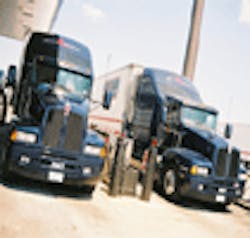See more on truck fuel efficiency
In two years, buses, medium- and heavy-duty trucks will be required to meet federally mandated fuel efficiency rules designed to reduce the level of greenhouse gas (GHG) emissions they produce.
Developed jointly by the U.S. Dept. of Transportation (DOT) and the Environmental Protection Agency (EPA), along with input from the trucking industry, environmental groups, and state governments – especially California – the standards go into effect in stages between 2014 and 2018 and impose different fuel efficiency targets based on the size and weight of the vehicle involved:
- Most, but not all, tractor-trailers will be required to achieve up to approximately a 20% reduction in fuel consumption and GHG emissions by model year 2018, saving up to 4 gals. of fuel for every 100 mi. traveled.
- For heavy-duty pickup trucks and vans, separate standards are required for gasoline-powered and diesel trucks. These vehicles will be required to achieve up to about a 15% reduction in fuel consumption and GHG emissions by model year 2018. Under the finalized standards a typical gasoline or diesel powered heavy-duty pickup truck or van could save 1 gal. of fuel for every 100 mi. of travel.
- Vocational vehicles – including delivery trucks, buses, and garbage trucks – will be required to reduce fuel consumption and greenhouse gas emissions by approximately 10% by model year 2018. These trucks could save an average of 1gal. of fuel for every 100 mi. of travel.
The Obama Administration believes these fuel efficiency mandates will reduce national oil consumption on an ongoing basis by a projected 530 million barrels of oil, cut carbon emissions by about 270 million metric tons, while saving vehicle owners and operators an estimated $50 billion in fuel costs.
“More efficient trucks on our highways and less pollution from the buses in our neighborhoods will allow us to breathe cleaner air and use less oil, providing a wide range of benefits to our health, our environment and our economy,” said EPA administrator Lisa Jackson in a statement, estimating that these fuel efficiency standards should improve air quality by reducing particulate matter and ozone, resulting in societal benefits ranging from about $1.3 billion to $4.2 billion in 2030.
DOT and EPA noted that different “measuring sticks” will apply to each category of vehicle. For example, heavy-duty pickup trucks and vans must meet targets for gallons of fuel consumed per mile as well as grams of carbon dioxide (CO2) emissions per mile.
However, the other two categories of trucks – tractor-trailers and vocational vehicles – must meet targets for gallons of fuel consumed and GHG emissions per ton-mile. This figure is calculated by dividing gallons of fuel consumed and grams of CO2 emissions per mile by tons of freight hauled, the agencies said.
Within each of the three categories of trucks, even more specific targets are laid out based on the design and purpose of the vehicle – such as a semi truck with a low roof versus a semi truck with a high roof – with fuel efficiency gains charted for each year and for each vehicle category and type, both DOT and EPA noted.
About the Author
Sean Kilcarr
Editor in Chief
Sean Kilcarr is a former longtime FleetOwner senior editor who wrote for the publication from 2000 to 2018. He served as editor-in-chief from 2017 to 2018.
